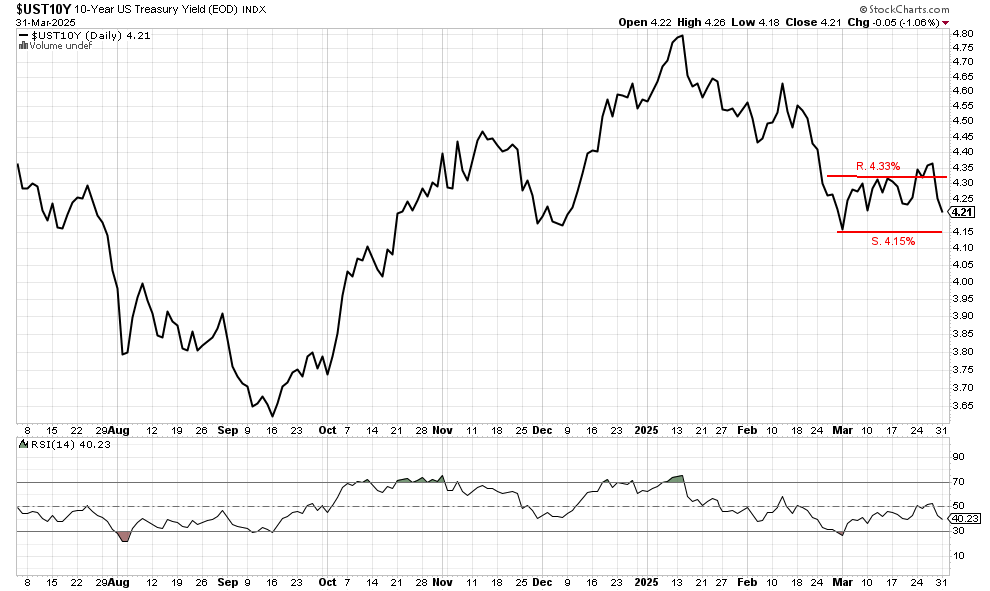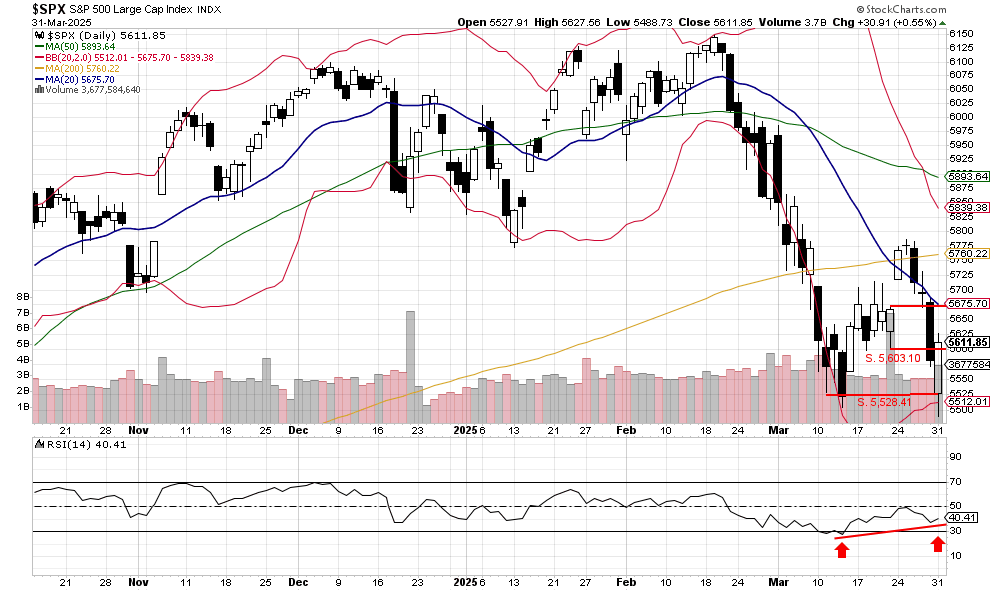Morning Brief

Headline News:
The S&P 500 futures are down 28 points and are trading 0.5% below fair value, the NASDAQ 100 futures are down 91 points and are trading 0.5% below fair value, and the Dow Jones Industrial Average futures are down 247 points and are trading 0.6% below fair value.
Early trading features a negative bias as investors wait for the Trump administration’s latest tariff measures to be announced tomorrow. There’s also some carryover downside momentum after equities’ weak showing in the first quarter.
Treasury yields are sharply lower, reflecting safe-haven buying before the tariff announcements. The 10-yr yield is down nine basis points to 4.16%, and the 2-yr yield is down six basis points to 3.85%.
The economic calendar today includes the final March S&P Global US Manufacturing PMI at 9:45 ET, and the March ISM Manufacturing Index, February JOLTS – Job Openings, and February Construction Spending at 10:00 ET.
(Michael Gibbs, Managing Director, Lead Portfolio Manager )
Markets:
The S&P 500 initially dropped to a new low of 5,488.73, but buyers stepped in, driving a strong rebound that pushed the index higher to close at 5,611.85. This rally broke through two key resistance levels, with the RSI also closing higher—further supporting the bullish momentum. While there is potential resistance at 5,670.84, we believe that level is unlikely to be tested today, as new tariffs are set to take effect tomorrow. Meanwhile, the 10-year Treasury yield continued its decline and currently stands at 4.16% as of this morning.
We are currently Intermediate-term bullish and short-term bullish.


John N. Lilly III CPFA
Accredited Portfolio Management Advisor℠
Accredited Asset Management Specialist℠
Portfolio Manager, RJFS
Partner, DJWMG
Windsor Wealth Planners & Strategist
Futures trading is speculative, leveraged, and involves substantial risks. Investing always involves risk, including the loss of principal, and futures trading could present additional risk based on underlying commodities investments.
The Relative Strength Index (RSI), developed by J. Welles Wilder, is a momentum oscillator that measures the speed and changes of price movements.
The percentage of stocks trading above a specific moving average is a breadth indicator that measures internal strength or weakness in the underlying index. The 50-day moving averages are used for short-to-medium-term timeframes, while the 150-day and 200-day moving averages are used for medium-to-long-term ones. Signals can be derived from overbought/oversold levels, crosses above/below 50%, and bullish/bearish divergences.
The Dow Jones Industrial Average (DJIA), commonly known as “The Dow,” is an index representing 30 stocks of companies maintained and reviewed by the editors of the Wall Street Journal. The Russell 2000 Index measures the performance of the 2,000 smallest companies in the Russell 3000 Index, which represents approximately 8% of the total market capitalization of the Russell 3000 Index.
The S&P 500 is an unmanaged index of 500 widely held stocks that is generally considered representative of the U.S. stock market. Past performance may not be indicative of future results. Keep in mind that individuals cannot invest directly in any index, and index performance does not include transaction costs or other fees, which will affect actual investment performance. Individual investors’ results will vary. Opinions expressed are those of the author, John N. Lilly III, and not necessarily those of Raymond James. “There is no guarantee that these statements, opinions, or forecast provided herein will prove to be correct. “The information contained was received from sources believed to be reliable, but accuracy is not guaranteed. Investing always involves risk, and you may incur a profit or loss. No investment strategy can guarantee success. The charts and/or tables presented herein are for illustrative purposes only and should not be considered as the sole basis for your investment decision. International investing involves special risks, including currency fluctuations, different financial accounting standards, and possible political and economic volatility. Investing in emerging markets can be riskier than investing in well-established foreign markets.
This is not a recommendation to buy or sell any company’s stock mentioned above.
US government bonds and treasury bills are guaranteed by the US government and, if held to maturity, offer a fixed rate of return and guaranteed principal value. US government bonds are issued and guaranteed due to the federal government’s timely principal and interest payment. Bond prices and yields are subject to change based on market conditions and availability. If bonds are sold prior to maturity, you may receive more or less than your initial investment. Holding bonds to term allows redemption at par value. There is an inverse relationship between interest rate movements and bond prices. Generally, when interest rates rise, bond prices fall, and when interest rates fall, bond prices generally rise.
The Nasdaq 100 (^NDX) is a stock market index made up of 103 equity securities issued by 100 of the largest non-financial companies listed on the NASDAQ. It is a modified capitalization-weighted index. It is based on exchange and not an index of U.S.-based companies.
The Russell 2000 Index is a stock market index that measures the performance of the 2,000 smaller companies included in the Russell 3000 Index. It is managed by London’s FTSE Russell Group and is widely regarded as a bellwether of the U.S. economy because it focuses on smaller companies that focus on the U.S. market.



